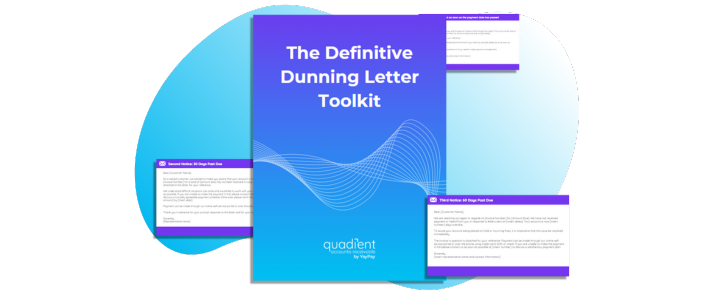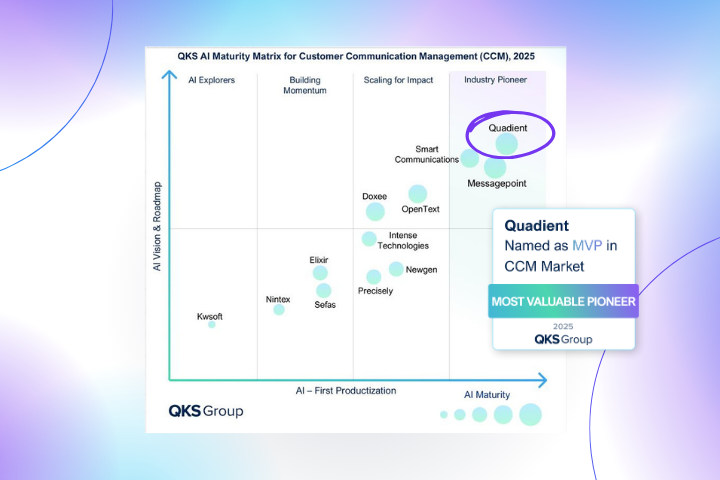
According to a recent study, 93% of businesses experience late payments, and the average organization writes off 1.5% of its receivables. Those sorts of numbers emphasize the importance of having a strategy in place when customers can't — or won't — meet their payment obligations on time.
It is a sensitive process. You want to ensure that your company gets the money it is owed, while maintaining the valuable customer relationships you have built and cultivated.
Creating effective dunning letters is essential to achieving that goal. To assist you, Quadient has compiled several best practices, as well as prewritten dunning letter templates that will help your organization accelerate the collection process.
What are dunning letters?
A dunning letter is a communication — typically an email or physical letter — sent to an account after it has gone past due. Creating a dunning letter process is a vital part of keeping your Days Sales Outstanding (DSO) low. In turn, this keeps your cash flow healthy.
Just how detrimental are late payments? Research indicates that they cost small and mid-size businesses $3 trillion a year.
Featured Resource: The Definitive Dunning Letter Toolkit

The dunning letter timeline
There’s no strict rule as to how often your payment notices should be issued, but there are some standard practices. Typically, the first is sent when an account is 30 days past due, with the subsequent communications going out at 60, 90, and 120 days.
Of course, depending on your company's specific needs, this can be adapted as needed. Sending too few or spacing them too far apart may increase the odds that the issue will be forgotten about. However, you'll want to schedule them in a way that won’t be considered undue harassment. To protect your organization, it is important to know all applicable regulations regarding collections to ensure that your letters and follow-up adhere to them.
What should they contain?
The contents of the letter will vary depending on how far behind the account has fallen. The first notification should be a simple, cordial note stating that payment is overdue and needs to be resolved as soon as possible. It is even worth including a brief mention that if payment has been made, then the customer should disregard the message. This is particularly relevant if your business still accepts manual payments such as checks, as they may have been mailed but have not yet arrived.
Your first communication should be sent as soon as the payment date has gone past due and should resemble the dunning letter example below.
Hi [Contact First Name],
We know that life can be busy, and it’s easy for things to fall through the cracks. This is just a brief note to remind you that [Invoice Number] for [Amount Due] was due on [Due Date]. The invoice is attached for your reference.
If you have already paid, please ignore this email. If you have not yet paid, please do so as soon as possible.
Please reach out with any questions or if you need to make payment arrangements.
Thank you,
[insert representative name and contact information]
At 60 days, and with each communication thereafter, the tone should become more assertive, requesting that the issue be resolved immediately. Communications should also clearly explain the potential consequences of not doing so.
The collections email template below provides an example of the verbiage to use.
Dear [Customer Name],
We are reaching out again regarding [Invoice Number] for [Amount Due]. We have not received payment or heard from you in response to letters sent on [insert dates]. Your account is now [insert number] days overdue.
To avoid your account being placed on hold or incurring fines, it is imperative that this issue be resolved immediately.
The invoice in question is attached for your reference. Payment can be made through our online self-service portal or over the phone using credit card, ACH, or check. If you are unable to make the payment in full, please contact us as soon as possible on [insert number] to discuss a satisfactory payment plan.
Sincerely,
[insert representative name and contact information]
If the issue remains unresolved, you may wish to inform the customer that a formal collections process will begin. If legal action is to be pursued — typically at the 120-day point — this should be clearly stated in the text.
This sample dunning letter displays the type of language to use.
Dear [insert name],
As of today, your account is 120 days past due. We have reached out on multiple occasions to request payment for [invoice number] in the amount of [amount] without response.
As a result, your account has accrued the following fees [insert fees] and has been reported to the appropriate credit agencies. Because of your lack of response, legal action must be taken as well.
If this matter is not resolved immediately, then all options available may be considered, including court proceedings with our lawyers/attorneys representing us accordingly.
Please contact us immediately at [phone number].
Because they could be used in court, there are certain dunning letter requirements that should always be included, such as an attached copy of the original bill – which should include invoice number, date, and total amount due, as well as information on any fees or interest charged because of the delayed payment.
Providing a variety of options and instructions on how the customer can quickly make their payment will also increase the likelihood of the problem being resolved.
Crafting an effective subject line
While the content of your dunning letter is the most important element, don't underestimate the impact of an effective subject line. It should convey a sense of urgency and use direct language. That means avoiding euphemisms like "payment issue" and focusing on language the compels a response. Phrases like "Action Required" and "Final Notice" communicate that the notice must be resolved immediately.
It is also useful to include the name of your company in the subject line. This provides the customer with immediate clarity on who they are dealing with and the order in question.
Here are three examples of simple but impactful subject lines:
- Attention Required: Your payment to [insert company name] is late
- Urgent: Complete your payment to [insert company name]
- Final Notice regarding your invoice with [insert company name]
Are there any other steps required?
A good rule of thumb is to reach out to the customer by telephone the day after each letter is sent. Speaking directly to a client can help ensure that the original invoice was actually received and that any confusion or disagreement regarding the bill is addressed quickly. This will help keep the subject top of mind.
You will also want to keep a detailed record of each communication made. In addition to this, using standardized templates for each letter is advisable. Not only will this ensure consistent messaging; it will make the process more efficient.
It may also be helpful to add contacts — such as the customer's account or sales representative — to these emails. Doing so will provide greater internal transparency and ensure that the account is receiving consistent messaging between departments. The individual sales representative can also reach out to the customer to facilitate a resolution or obtain information regarding why payment is late.
Can automation help?
Using AR automation software such as Quadient AR can help simplify the process. Invoices can be sent out monthly or weekly, depending on the terms you offer, and dunning letters can be delivered at regular, pre-scheduled intervals after an account has gone past due.
AR automation helps structure a customer communication strategy in which messaging is frequent, informative, and well-timed. Through automation, you can ensure that communication is tailored to your customers based on any number of differentiating factors, such as region, product line, risk or business size." - Anthony Venus, co-founder & CEO of Quadient Accounts Receivable by YayPay
The solution keeps a detailed record of all communications and provides customers with an easy, self-service portal so that payments can be made from anywhere at any time.








